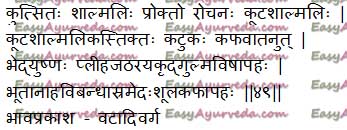Kuta Shalmali (Kapok Tree) – Uses, Remedies, Research, Side Effects
By Dr Renita D’Souza
Kapok tree (Ceiba pentandra) is an Ayurvedic medicinal plant known by the name Kutashalmali. It is traditional used in the treatment of liver and spleen disorders, ailments related to digestive fire, constipation, blood diseases etc.
Roots are diuretic, strength booster and aphrodisiac.
Its gum is styptic in nature. Tender leaves are unctuous and also styptic in nature. The bark and the leaves of this plant are used in the treatment of diabetes, dizziness, headache, hypertension and fever. Young fruits are used in the treatment of snake bite.
Botanical Name – Ceiba pentandra
Family – Bombacaceae
Medicinal Qualities
Taste – Bitter (tiktha), Pungent (katu)
Virya (potency) – hot (ushna)
Qualities
Bhedya – laxative
Table of Contents
Traditional Uses of Kuta shalmali
Pliha – splenomegaly
Jatara – ascites
Liver disorders
Gulma – abdominal tumours
Visha – poisoning, toxic conditions
Bhuta – psychiatric disorders, anti microbial
Aanaha – abdominal distention
Vibanda – constipation
Blood diseases
Meda – Diseases related to fat tissue
Shoola – pain
Effect on Tridosha
Balances kapha and vata dosha.
Sanskrit Synonyms
Kuthsitashalmali, Rochana, Kutashalmali
Kuta shalmalika
Read – Shalmali, Silk Cotton Tree: Ayurveda Use, Medicines, Home Remedies
Traditional Remedies
- Decoction of flowers acts as laxative and can be used in constipation.
- Gum is used to treat bed wetting in children and diarrhoea.
- Due to the diuretic nature of its roots, they are made used in the treatment of oedema and ascites.
Morphology of Ceiba pentandra
Ceiba pentandra is a tree growing up to more than 100 feet. Palmate leaves, arranged alternately, gathered at the ends ofwith 5-9 leaflets, 20 cm long. Pods 15 cm long, contains seeds surrounded by fluffy, yellowish fibre. Flowers are white in colour. Seed yields yellow colour oil which has pleasant and mild odour.
Tree yields dark brown, opaque gum. It is known as Hathimanke Gond.
Controversy
The roots of tree which is less than 1 year is sold in market by the name Safed Musali or Simul Musala. But there is also a separate herb Safed musali which is a small plant known as Asparagus adscendens.
Read – Safed Musli: Asparagus adscendens Uses, Research, Side Effects
In Kaiyadeva nighantu, Rajanighantu and Dhanvantari Nighant, Kuta shalmali is also mentioned as a synonym of Rohitaka plant.
Side Effects of Koota shalmali
There are no recorded side effects.
High oral dosage may cause diarrhoea due to its laxative property.

Ayurvedic Medicines with Kapok as ingredient
Dadimavaleha – It is a effective Ayurvedic medicine for diarrhoea, dysentery, bleeding disorders such as ulcerative colitis, adbominal colic etc
Interaction with medicines, supplements
Can this be used while taking Homeopathic medicine?
Yes. This product does not react with homeopathic medicine.
Can
this medicine be continued while taking supplements like multivitamin tablets,
Omega 3 fatty acids etc?
Yes. Generally, this product goes well with most
of the dietary supplements. However, if you are taking more than one product
per day, please consult your doctor for an opinion.
With western
medicines
Seek your
doctor’s advice if you are taking this product along with other western
(allopathic / modern) medicines. Some Ayurvedic herbs can interact with modern
medicine.
If both Ayurvedic and allopathic medicines are advised together, then it is
best to take Allopathic medicine first, wait for 30 minutes and then take the
Ayurvedic medicine.
Research
Hypogylcemic Activity – A research study was done to detect hypoglycemic properties of the aqueous extract from the stem bark of Ceiba pentandra in Dexamethasone-Induced Insulin Resistant Rats. The result of the study has concluded that dried decoction from the stem bark of C. pentandra possesses potent antihyperglycemic effects and improves insulin resistance and dyslipidemia caused by dexamethasone.
Antibacterial and Antioxidant activity –
A research study conducted to evaluate antibacterial and antioxidant activity of ethanolic extract of Ceiba pentandra leaves and its phytochemicals analysis using GC-MS. The result showed potential antimicrobial and antioxidant activity of ethanol derived extract of Ceiba pentandra leaves.
Names in different languages
English Name – White silk cotton tree, Kapok, Ceiba
Hindi Name – Safed semal, Hatiaan, Katan, Safed Savara
Marathi Name – Pamdari samvar, Samali
Bengali Name – Shweth semul
Gujarati Name – Kapas
Telugu Name – Burugu, Tellaburaga
Tamil Name – Halvam, Pancu, Ilavam
Kannada Name – Biliburaga, Dudi
Manipuri Name – Moreh tera
Assamese Name – Simolu
Malayalam Name – Pannimaram, Panji maram
Spanish Name – Ceiba
Chinese Name – Mumian
Classical Categorisation
Bhavaprakasha Nighantu – Vatadi Varga
Click to Consult Dr Renita D’Souza










